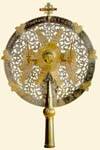|
|
| Byzantine Minor Arts |
1661 Dionysiou Monastery Silver, parcel-gilt, enamel, corals and pearls 36.5 x 24 cm Russia |
|

|
A large silver disk forms the body of each of these two hexapteryga (liturgical fans), a conical socket at the bottom serving to admit a wooden shaft. In the centre of each face is a silver-gilt seraph: the head, worked in low relief and touched with niello, is applied upon the fan. The upper and lower pairs of wings are folded and crossed; the middle pair are spread wide, behind the outstretched arms and the hands brandishing swords. The shoulders are decorated with beading and a pattern of tiny rosettes. The plumage is suggested by alternating vertical and horizontal hatching, creating ribbons of lozenges, the pattern on the middle wings being slightly different from the rest. The field surrounding each seraph is covered with a fret of flora arabesques of the type known as rumi, characteristic of Ottoman art (Petsopoulos 1982, pp. 7-8, figs. 49, 53). Crowning each disk is an enamelled cross decorated with pearls, coral beads and a floral motif in the corners, and displaying the instruments of the Passion; this is a variant of a Russian ornament (Postnikova-Loseva et al. 1983, p. 43 and fig. on p. 44). The dedicatory inscription, punctuated by six small gilt seraphs in three-quarter view, all facing the centre, occupies the perimeter of each disk, on both sides: a. 'ΔΕΗΣΙΣ ΤΟΥ ΔΟ(Υ)ΛΟΥ ΤΟΥ ΘΕΟΥ ΓΓΙΝΗ ΚΕ ΤΗΣ ΣΗΜΒΗΑΣ ΑΥΤΟΥ ΔΙΜΗΤΡΟ / ΚΑΙ ΤΩΝ ΤΑΙΚΝΩΝ ΓΕΩΡΓΙΟΥ ΚΑΙ ΝΙΚΟΛΑΟΥ ΚΕ ΕΚ ΧΩΡΑΣ ΔΟΜΠΡΕΝΑ ΕΤΙ ΧΡΙΣΤΟΥ ΑΧΞΑ' (Supplication of the servant of God Ginis of Dobrena and his wife Dimitro and their children George and Nicholas in the year of Our Lord 1661), and on the same side, at the neck of the shaft: 'ΘΕΩΘΟ/ΥΕΡΟ' (?) (undeciphered), and b. 'ΚΕ ΔΗΑ ΣΗΝΔΡΟΜΗΣ ΤΟΝ ΟΣΙΟΤΑΤΩΝ ΝΗΚΗΦΟΡΟΥ ΚΕ ΝΗΚΙΤΑ ΤΩΝ ΙΕΡΟΜΟΝΑΧΩΝ / ΕΚ ΤΗΣ ΜΟΝΗΣ ΤΟΥ ΤΙΜΙΟΥ ΠΡΟΔΡΟΜΟΥ ΤΟΥ ΑΓΙΟΥ ΔΙΟΝΥΣΙΟΥ ΚΙΜΕΝΗ ΙΠΟΚΑΤΟΥ ΤΟΥ ΜΙΚΡΟΥ ΑΝΘΟΥ' (And with the contribution of the venerable hieromonks Nikephoros and Niketas of St Dionysios' Monastery of John the Prodrome lying under the Little Flower). The socket for the staff is fixed to the solid lower part of the disk. Etched into the bulbous gilt collar just under the disk are narrow slightly oblique vertical strips decorated with tiny stylized palmettes. Liturgical fans displaying six-winged seraphs developed from older, early Christian, silver models, which indeed are still being made (Mundell-Mango 1986, nos. 31-2, pp. 147-54). These gilt seraphs, with their finely wrought details, seem to hover above the darker fret-work of the ground. The swords they brandish - in the place of the more usual banners or sceptres - are modelled on seventeenth-century Russian or Turkish blades (Larcenko 1988, pp. 156-7, fig. 110. Jablonskaja 1988, pp. 211-2, figs. 141-2), and recall both scenes of apocalyptic character in Russian iconography (Schennikova 1990, pp. 62-3, fig. 182) and the cherubs, frequently confused with seraphs, 'placed at the east of the Garden of Eden, and a flaming sword which turned every way' (Genesis 3: 24. Popov 1993, fig. 173). Similar fret-work arabesques, but richer and more luxuriant, are found on an older Russian hexapterygon (1656), now in the Kremlin (Vishnevskaya 1995, p. 148). This ornament, like the tiny palmettes on the Dionysiou hexapteryga, bears witness to the impact of the art of the East on Russian silver and goldsmith's work in the sixteenth and seventeenth centuries (Gold aus dem Kreml 1989, no. 22. Tesoros del Kremlin 1990, no. 10). The tiny daisies decorating the tops of the shoulders, especially in conjunction with spiralling tendrils highlighted with niello, seen on a number of other works as well, attest to the close links between Russian and Constantinopolitan art during this period (Sizova 1993, p. 121, fig. 75. Kurz 1975, p. 57, fig. 16). The oldest known rhipidia (fans) with fret-work arabesques (1601) are preserved in the Patriarchate in Constantinople (Soteriou 1938, p. 63, fig. 18). Rhipidia in the Chozobiotissa Monastery on the island of Amorgos (1682) and the Benaki Museum in Athens (1705) prove that this type of ornamentation was still being used in the early eighteenth century (Koutelakis 1996, fig. 33. Ballian 1992 (2), no. 32, pp. 67-9). The hexapteryga in the Monastery of Dionysiou are products of an age in which the Russian Church was very powerful, and Russia itself maintained close contacts with Mount Athos (Vishnevskaya 1995, pp. 134-9. Greek Documents 1995, p. 42).
| |
|
Bibliography: Unpublished.
| ||
| Y. I.-P. | ||
| Index of exhibits of Monastery of Dionysiou 17th century |
||
Reference address : https://www.elpenor.org/athos/en/e218ci49.asp